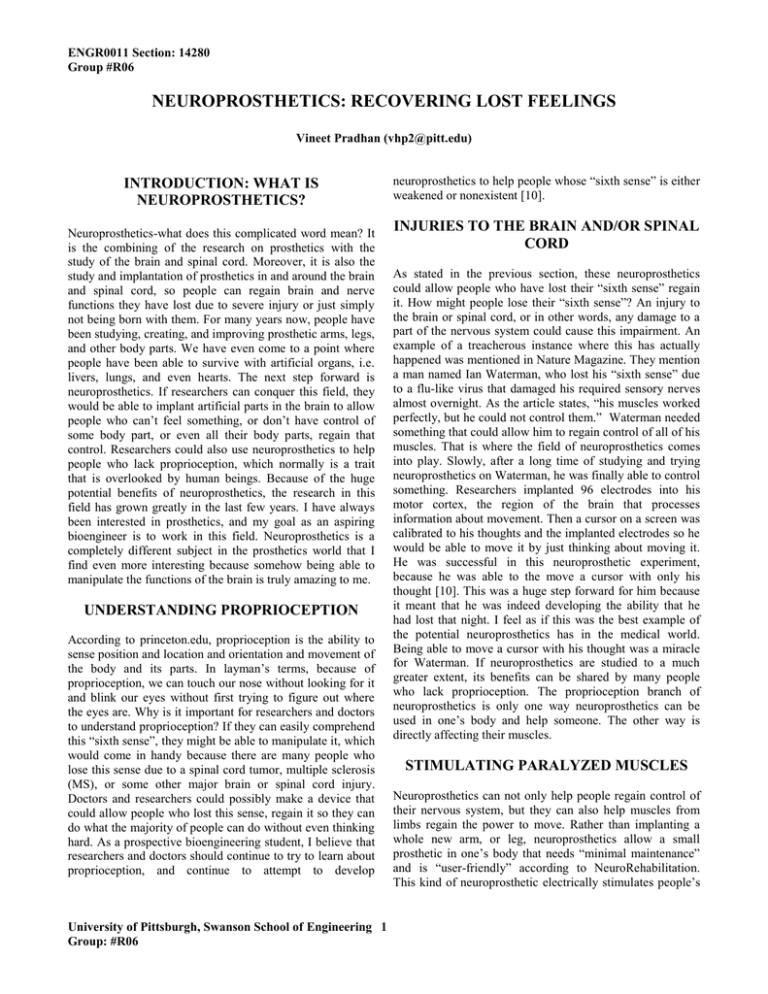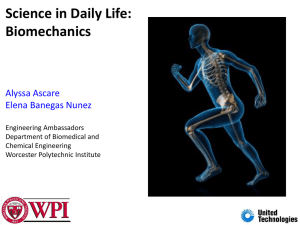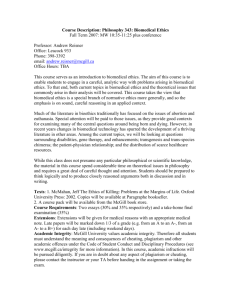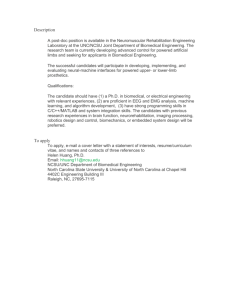Writing Assignment 3
advertisement

ENGR0011 Section: 14280 Group #R06 NEUROPROSTHETICS: RECOVERING LOST FEELINGS Vineet Pradhan (vhp2@pitt.edu) INTRODUCTION: WHAT IS NEUROPROSTHETICS? Neuroprosthetics-what does this complicated word mean? It is the combining of the research on prosthetics with the study of the brain and spinal cord. Moreover, it is also the study and implantation of prosthetics in and around the brain and spinal cord, so people can regain brain and nerve functions they have lost due to severe injury or just simply not being born with them. For many years now, people have been studying, creating, and improving prosthetic arms, legs, and other body parts. We have even come to a point where people have been able to survive with artificial organs, i.e. livers, lungs, and even hearts. The next step forward is neuroprosthetics. If researchers can conquer this field, they would be able to implant artificial parts in the brain to allow people who can’t feel something, or don’t have control of some body part, or even all their body parts, regain that control. Researchers could also use neuroprosthetics to help people who lack proprioception, which normally is a trait that is overlooked by human beings. Because of the huge potential benefits of neuroprosthetics, the research in this field has grown greatly in the last few years. I have always been interested in prosthetics, and my goal as an aspiring bioengineer is to work in this field. Neuroprosthetics is a completely different subject in the prosthetics world that I find even more interesting because somehow being able to manipulate the functions of the brain is truly amazing to me. UNDERSTANDING PROPRIOCEPTION According to princeton.edu, proprioception is the ability to sense position and location and orientation and movement of the body and its parts. In layman’s terms, because of proprioception, we can touch our nose without looking for it and blink our eyes without first trying to figure out where the eyes are. Why is it important for researchers and doctors to understand proprioception? If they can easily comprehend this “sixth sense”, they might be able to manipulate it, which would come in handy because there are many people who lose this sense due to a spinal cord tumor, multiple sclerosis (MS), or some other major brain or spinal cord injury. Doctors and researchers could possibly make a device that could allow people who lost this sense, regain it so they can do what the majority of people can do without even thinking hard. As a prospective bioengineering student, I believe that researchers and doctors should continue to try to learn about proprioception, and continue to attempt to develop University of Pittsburgh, Swanson School of Engineering 1 Group: #R06 neuroprosthetics to help people whose “sixth sense” is either weakened or nonexistent [10]. INJURIES TO THE BRAIN AND/OR SPINAL CORD As stated in the previous section, these neuroprosthetics could allow people who have lost their “sixth sense” regain it. How might people lose their “sixth sense”? An injury to the brain or spinal cord, or in other words, any damage to a part of the nervous system could cause this impairment. An example of a treacherous instance where this has actually happened was mentioned in Nature Magazine. They mention a man named Ian Waterman, who lost his “sixth sense” due to a flu-like virus that damaged his required sensory nerves almost overnight. As the article states, “his muscles worked perfectly, but he could not control them.” Waterman needed something that could allow him to regain control of all of his muscles. That is where the field of neuroprosthetics comes into play. Slowly, after a long time of studying and trying neuroprosthetics on Waterman, he was finally able to control something. Researchers implanted 96 electrodes into his motor cortex, the region of the brain that processes information about movement. Then a cursor on a screen was calibrated to his thoughts and the implanted electrodes so he would be able to move it by just thinking about moving it. He was successful in this neuroprosthetic experiment, because he was able to the move a cursor with only his thought [10]. This was a huge step forward for him because it meant that he was indeed developing the ability that he had lost that night. I feel as if this was the best example of the potential neuroprosthetics has in the medical world. Being able to move a cursor with his thought was a miracle for Waterman. If neuroprosthetics are studied to a much greater extent, its benefits can be shared by many people who lack proprioception. The proprioception branch of neuroprosthetics is only one way neuroprosthetics can be used in one’s body and help someone. The other way is directly affecting their muscles. STIMULATING PARALYZED MUSCLES Neuroprosthetics can not only help people regain control of their nervous system, but they can also help muscles from limbs regain the power to move. Rather than implanting a whole new arm, or leg, neuroprosthetics allow a small prosthetic in one’s body that needs “minimal maintenance” and is “user-friendly” according to NeuroRehabilitation. This kind of neuroprosthetic electrically stimulates people’s Vineet Pradhan paralyzed muscles so they can move again. The people that would need this kind of neuroprosthetic would be the ones that can feel their leg, or arm, but they cannot move it. They know how to move it, but it won’t move. Not only can these neuroprosthetics control limbs, they can also control things like the bladder, assist in breathing, and bowel movements. In an extremely severe case, where someone has lost their limb and the nerves to access that limb, doctors could potentially combine traditional prosthetics and neuroprosthetics and provide a limb that has full feeling, which would truly be remarkable. Developing this kind of super artificial connection in one’s body is referred to as “hybrid neuroprosthetics”. concern, researchers have created a multilayer coating of SiC and Parylene C. This has reduced the chance for nerve tissue damage because both these substances provide the device with a layer that is unreactive with anything around it, so the metal or the material the substance is made of will not react negatively with anything else in the body. This multilayer coating also makes the device somewhat softer to the outside, which provides protection for the nerve tissue around it so it doesn’t get ruptured. If researchers are able to eliminate this major danger, the neuroprosthetic field could gain many more supporters and the knowledge would take off [9]. Along with the chance of nervous system damage, there is also chance for negative feedback from the immune system if a neuroprosthetic is implanted. HYBRID NEUROPROSTHETICS Immune System Response The IEEE Transactions on Biomedical Engineering says, “the hybrid neuroprosthetic system is emerging as one of the most innovative areas of robotics and engineering”. This is because as I said earlier, being able to incorporate both traditional prosthetics and neuroprosthetics in the same body part is a big step forward in the medical world. A hybrid neuroprosthetic can be classified with three criteria: level of hybridness, level of augmentation, and level of connection to the nervous system [3]. Level of hybridness is how connected it is to the human body and whether it links the artificial and natural systems together. Level of augmentation is how powerful it is and how much it can do. Level of connection to the nervous system is whether the neuroprosthetic is connected to the peripheral nervous system (PNS), the central nervous system (CNS), or both. [3]. All of the hybrid prosthetics use electrical stimulation to operate the way they are built. These many variations mean that hybrid neuroprosthetics can help many people with different types of problems or disorders. Throughout this article there have only been remarkable concepts discussed, but of course there are many challenges that researchers and doctors have to overcome to make neuroprosthetics a viable option for patients. Whenever a foreign substance enters the body, the immune system always decides whether the substance belongs or not. Then it gives either positive or negative feedback based on what it believes. If wires and percutaneous connectors are implanted into someone’s body, one could only assume that the body won’t like the face that they are present and will react negatively [9]. This is the other big challenge doctors and researchers face when talking about implanting neuroprosthetics. This hurdle is probably bigger than the nerve tissue damage one because this is something the doctors would need to wait for some period of time to see how the implanted device has affected the body, positively or negatively [5]. ETHICAL COMMENTARY AND CONCERNS Critics of Neuroprosthetics As with any major breakthrough with possible complications, there are of course those critics who believe the complications are far worse than the benefits. As mentioned in previous sections, implanting a neuroprosthetic device has the potential of damaging one’s nerve tissue. The neuroprosthetic device could also result in a negative response by the immune system. According to the first section of the National Society of Professional Engineers (NSPE)’s code of ethics, “Engineers shall hold paramount the safety, health, and welfare of the public” [6]. This is the main section of this code of ethics that critics are pointing to when they say the benefits of neuroprosthetics are not worth the risk. Although biomedical engineers are dealing with a delicate part of the body with these neuroprosthetics, I believe that these devices are indeed worth the risk, because as research in this field improves, there will be less and less risk associated with this field. POSSIBLE COMPLICATIONS OF NEUROPROSTHETICS Damages to Nerve Tissues Due to Implantation of Neuroprosthetics Implanting anything into one’s body could cause negative feedback from the body. People have to be especially careful when manipulating the brain and nerve areas as well, because one microscopic mistake could lead to a massive problem for someone for the rest of their life. Damaging nerve tissue when inserting and using these neuroprosthetics has been one of the main concerns for researchers and doctors who have chosen to study this subject. According to the Nanomedicine Magazine, to attempt to combat this 2 Vineet Pradhan to increase the competence, prestige, and honor of the biomedical engineering profession” [7]. Breakthroughs in the neuroprosthetic field are definitely examples that biomedical engineers should use to lead and motivate their co-researchers and co-workers to achieve more. Biomedical Engineering Research The ultimate goal of the researchers should be to build these neuroprosthetic devices with as less risk as possible, and have these device be as safe as possible. The Biomedical Engineering Society’s code of ethics has a whole section for researchers. The first part of this section states that all biomedical engineering researchers should “Comply fully with legal, ethical, institutional, governmental, and other applicable research guidelines, respecting the rights of and exercising the responsibilities to human and animal subjects, colleagues, the scientific community and the general public” [7]. In simpler terms, this means that biomedical engineering researchers should abide by all the rules that go along with safety in the research laboratory and they should treat the subjects they test their devices on in a humane manner. In my opinion, this is the most important of the ethical codes that biomedical engineering researchers should abide by because safety of the subjects and safety of the people who actually use the device is most important. This is especially important when dealing with neuroprosthetics and the nervous system. Since the brain, spinal cord, and nerves are very delicate and could be manipulated easily, it is crucial for researchers to maintain legality and respect the rights of humans and animals, because they could potentially make a small change in the system and make a huge difference in the way someone thinks or feels. Another part of the Biomedical Engineering Society’s code that pertains to researchers states that all biomedical engineering researchers should also “Publish and/or present properly credited results of research accurately and clearly” [7]. This could be considered the “common sense” part of the biomedical engineering researchers’ code. Of course, if a biomedical engineer should truthfully talk about his or her research findings and explain what they have learned in a way that everyone interested can understand it. Just as biomedical researchers are constrained to these ethical laws, biomedical engineers directly involved in the professional aspect of the field also have their own ethics that they need to abide by. NSPE’s Take On Ethics The NSPE has a much broader view on ethics, since they have to incorporate all different fields of engineering. But of course there are many codes in the NSPE’s code of ethics that pertain to biomedical engineering and more specifically, the study and implantation of neuroprosthetics. One section in their code states “Engineers shall perform services only in the areas of their competence” [6]. This simply means that biomedical engineers and neuroprosthetic researchers should only be allowed to partake in neuroprosthetic studies if they are qualified to do so. This assures that people who are not as qualified and could produce partially erroneous results are not allowed to take part in this research. This makes neuroprosthetic research more official and will result in better studies. Another section of the code of ethics put forward by the NSPE says that “Engineers shall avoid deceptive acts” [6]. While performing research, or building neuroprosthetic devices, biomedical engineers should never try to cover up a mistake to save time, or exaggerate a finding to attempt to give them more credibility. Wrap-up on Ethics With every breakthrough comes controversy. The field of neuroprosthetics is no different from any other breakthrough. However, as long as biomedical engineers and biomedical engineering researchers abide by the codes of ethics put forth by the NSPE and Biomedical Engineering Society, there will be little or no problem in the future with these studies and devices. I hope that this field begins to lose critics and gain much more supporters, so peoples’ lives can be saved faster and they’ll have a much lower risk of problems due to neuroprosthetics. Biomedical Engineers’ Professional Obligations STUDYING ETHICS AS A FRESHMAN ENGINEER According to the Biomedical Engineering Society’s code of ethics, all biomedical engineers should “Use their knowledge, skills, and abilities to enhance the safety, health, and welfare of the public” [7]. This is almost exactly what it says in the NSPE’s code of ethics. The fact that this is the first statement in both the NSPE’s and the Biomedical Engineering Society’s code of ethics means that it is obviously important in the biomedical engineering and engineering world. Relating to neuroprosthetics, this applies in the sense that the studies they do and the devices they make should better the health of the people that wish to have that device implanted. The other “professional obligation” according to this code of ethics states that all biomedical engineers should “Strive by action, example, and influence Researching and learning about the previously unknown field of neuroprosthetics was definitely a great experience for me. Researching the codes of ethics and connecting it back to this field that I am newly interested in was also very interesting for me to do. I however, do not believe that learning and researching these things during my freshman year is as useful as learning and researching these things as a sophomore or junior would be. The main reason that I believe this is I currently haven’t taken an official bioengineering course yet, so right now I have no knowledge of bioengineering at all. Although reading about 3 Vineet Pradhan neuroprosthetics was interesting, I feel that I would have gotten more out of it if I had some bioengineering knowledge before I actually did the research. There were many articles that I skimmed that I think may have been more interesting if I was able to fully comprehend them. ADDITIONAL SOURCES [9] F. Solzbacher, R. Harrison, R. Normann, H. Oppermann, M. Klein, K. Koch (Sept. 2005). “Integrated neural interfaces arrays for neuroprosthetic applications.” Nanomedicine: Nanotechnology, Biology, and Medicine. (Online Article). http://www.sciencedirect.com.pitt.idm.oclc.org/ [10] A. Abbott. (Jul. 2006). “Neuroprosthetics: In Search of the Sixth Sense.” Nature. (Print Article). http://search.proquest.com.pitt.idm.oclc.org/ FINAL THOUGHTS The field of neuroprosthetics has opened up a whole new world of artificiality in the biomedical engineering and medical worlds. I believe that this issue deserves much attention because of the benefits it has. These breakthroughs could potentially provide people who can’t feel or access a limb to be able to use an artificial limb with artificial nerves and live a normal life. I hope to possibly take part in research in this field because I would love to help in the advancements of a field with such great potential. ACKNOWLEDGEMENTS I would like to thank all of the authors of the articles that helped contribute to this article. REFERENCES [1] N. Bhadra, J. Chae. (2009). “Implantable Neuroprosthetic Techonology.” NeuroRehabiltation. (Online Article). http://web.ebscohost.com.pitt.idm.oclc.org/ [2] J. Del R. Millan. (May-June 2009). “Neural Engineering: EPFL Center for Neuroprosthetics.” Engineering in Medicine and Biology Magazine. (Online Article). http://ieeexplore.ieee.org.pitt.idm.oclc.org/ [3] S. Micera. J. Carmena. (Jan. 2009). “Developing the Next Generation of Hybrid Neuroprosthetic Systems.” IEEE Transactions on Biomedical Engineering. (Online Article). http://ieeexplore.ieee.org.pitt.idm.oclc.org/he [4] V. Sharma. (Feb 2010). “Bidirectional Telemetry Controller for Neuroprosthetic Devices.” IEEE Transactions on Neural Systems and Rehabilitation Engineering. (Online Article). http://ieeexplore.ieee.org.pitt.idm.oclc.org/ [5] P. Musienko. (Nov. 2009). “Combinatory Electrical and Pharmacological Neuroprosthetic Interfaces to Regain Motor Function after Spinal Cord Injury.” IEEE Transactions on Biomedical Engineering. (Online Article). http://ieeexplore.ieee.org.pitt.idm.oclc.org/ [6]“NSPE Code of Ethics for Engineers.” NSPE. (Online Article). http://www.nspe.org/ [7] Biomedical Engineering Code of Ethics.” Biomedical Engineering Society. (Online Article). http://www.bmes.org/ [8] (May 2012). “The Neurodevice 2012 Report: Neuroprosthetics, Neuromodulation, Neurosurgery, Neurovascular Intervention and Neurosoftware.” NeuroInsights. (Online Article). http://www.lexisnexis.com/ 4






